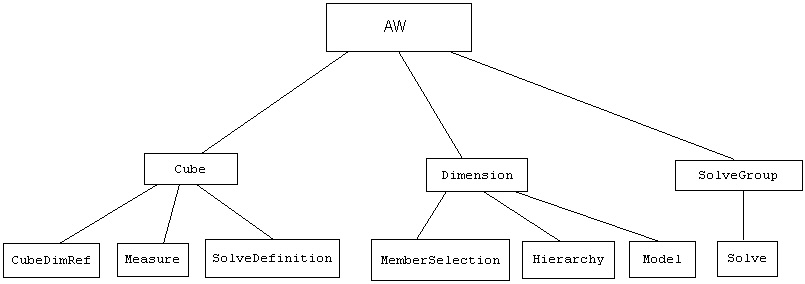 Description of object_hierarchy.jpg
Description of object_hierarchy.jpg
|
Oracle® OLAP Analytic Workspace Java API Reference 10g Release 2 (10.2) B14351-01 |
Object Hierarchy
The object model defines a set of hierarchical relationships between objects within a schema. Top-level objects in the hierarchy are owned by the analytic workspace. Second-level objects are owned by the top-level objects, and so on.
The name space of an object is defined by its full lineage. The analytic workspace name is not included in the lineage of the object. Top-level objects exist within the namespace of the schema.
The following diagram illustrates the primary ownership relationships between the top-level objects in the model.
 Description of object_hierarchy.jpg
Description of object_hierarchy.jpg
In most cases, dependent objects are optional. For example, a SolveGroup can contain several solves or no solves. In some cases, at least one instance of the dependent object is required. For example, a cube must have at least one measure. The 0-many relationships are illustrated in the UML diagrams available with the individual class descriptions.
Top-Level Objects
A Cube specifies a unit of multidimensional data. All the data in the Cube shares the same multidimensional structure. A Cube has at least one measure, which identifies a type of data, and at least one reference to a dimension. A Cube can own one or more solve definitions. A SolveDefinition is a set of instructions for aggregating or allocating the data of the cube or generating a forecast based on the data. A SolveDefinition is used by a Solve.
A Dimension specifies a list of values (dimension members) that can be used as an index to the data in a cube. A Dimension can own one or more groups of dimension members (MemberSelection) and one or or more hierarchies. A Dimension can also own one or more Model objects.
MemberSelection is a Level. When a Level is associated with a Hierarchy, it specifies a single position for all its members within the hierarchy. For example, a time dimension typically has a hierarchy with a Month level and a Year level.Hierarchy defines an ordered set of relationships between members in a dimension. There are two types of hierarchies: level-based hierarchies, which define an ordered set of levels, and parent-child hierarchies, which define parent-child relationships between the members of the dimension.Model is a set of interrelated equations whose results are a set of dimension members.A SolveGroup is a collection of solves. Each Solve uses a SolveDefinition to specify the aggregation, allocation, or forecasting of multidimensional data. Solves are ordered within a SolveGroup. The order determines when the calculations are performed during an analytic workspace build.
Data Mapping and Object Attributes
Subclasses of AWObject can be mapped to a data source and can own attributes. The subclasses of AWObject classes are Cube, Dimension, MemberSelection, HierarchyLevelAssociation, and Hierarchy. The classes that represent the mappings and the attributes are MappingGroup and Attribute. The subclass of AWObject owns the MappingGroup and Attribute objects associated with it.
The following diagram shows the objects that can be owned by any of the subclasses of AWObject.

Description of objhierattrmap.jpg.
Mapped objects can be loaded with data from relational tables. Measures, dimensions, and attributes can all be targets of a data load.
Attributes represent a quality or description of an object. Attributes may be used to restrict the current set of values associated with an object. In the current release, only dimensions can support attributes. If the attribute is to be applied to an object owned by a dimension, it can be projected to that object with an AttributeProjection.
Fully Qualified Object Names
Standard form naming conventions specify a full name for each logical object in an analytic workspace. The full name includes the name space to which the object belongs, the simple logical name, and the object type.
The name space is the lineage of the object in the object hierarchy. However, the analytic workspace name does not participate in the object lineage. Top-level objects exist within the name space of the schema.
The full name of an object is:
lineage.name.type
For example, the full name of the UNITS_CUBE_AW Cube is UNITS_CUBE_AW.CUBE. The full name of the UNITS_AW MEASURE is UNITS_CUBE_AW.UNITS_AW.MEASURE. The full name of the PRODUCT_ROLLUP_AW Hierarchy of the PRODUCT_AW Dimension is PRODUCT_AW.PRODUCT_ROLLUP_AW.HIERARCHY.
The full name of an object is its identifer. The getId method of a BaseObject instance returns the full name.